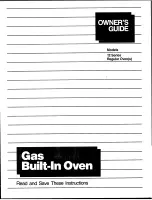
8
OTHER HELPFUL INFORMATION
COOKING UTENSILS
Shape of foods: Microwaves penetrate only about
1 inch (2.5cm) into foods; the interior portion of
thick foods is cooked as the heat generated on the
outside travels inward. In other words, only the
outer edge of any foods is actually cooked by
microwave energy; the rest is cooked by
convection. It follows then that the worst possible
shape for a food that is to be microwaved is a thick
cube. The corners will burn long before the center
is even warm. Round thin and ring shaped foods
cook most successfully in the microwave.
Quantity of foods: The number of microwaves in
your oven remains constant regardless of how
much food is being cooked. Therefore, the more
food you place in the oven, the longer the cooking
time. Remember to decrease cooking times by at
least one-third when halving a recipe.
MICROWAVE-SAFE UTENSILS
Never use metal or metal-trimmed utensils in
your microwave oven: Microwaves cannot
penetrate metal. They will bounce off any metal
object in the oven and cause arcing, an alarming
phenomenon that resembles lightening.
Most heat-resistant non-metallic cooking utensils
are safe for use in your microwave oven. However,
some may contain materials that render them
unsuitable as microwave cookware. If you have
any doubts about a particular utensil, there's a
simple way to find out if it can be used in your
microwave oven.
Testing utensils for microwave use: Place the
utensil in question next to a glass bowl filled with
water in the microwave oven. Microwave at power
HIGH for 1 minute. If the water heats up but the
utensil remains cool to the touch, the utensil is
microwave-safe. However, if the water does not
change temperature but the utensil becomes
warm, microwaves are being absorbed by the
utensil and it is not safe for use in the microwave
oven. You probably have many items on hand in
your kitchen that can be used as cooking
equipment in your microwave oven. Just read
through the following checklist.
1. Dinner plates: Many kinds of dinner-ware are
microwave-safe. If in doubt consult the
manufacturer's literature or perform the microwave
test, above.
2. Glassware: Glassware that is heat-resistant is
microwave-safe. This includes all brands of oven-
tempered glass cookware. However, do not use
delicate glassware, such as tumbler or wine
glasses, as these might shatter as the food warms.
3. Paper: Paper plates and containers are
convenient and safe to use in your microwave
oven, provided the cooking time is short and
foods to be cooked are low in fat and moisture.
Paper towels are also very useful for wrapping
foods and for lining baking trays in which greasy
foods, such as bacon, are cooked. In general,
avoid colored paper products as the color may run.
4. Plastic storage containers: These can be used
to hold foods that are to be quickly reheated.
However, they should not be used to hold foods
that will need considerable time in the oven as hot
foods will eventually warp or melt plastic
containers.
5. Plastic cooking bags: These are microwave-
safe provided they are specially made for cooking.
However, be sure to make a slit in the bag so
that steam can escape. Never use ordinary plastic
bags for cooking in your microwave oven, as they
will melt and rupture.
6. Plastic microwave cookware: A variety of
shapes and sizes of microwave cookware is
available. For the most part, you can probably cook
with items you already have on hand rather than
investing in new kitchen equipment.
7. Pottery, stoneware, and ceramic:
Containers made of these materials are usually
fine for use in your microwave oven, but they
should be tested to be sure.
CAUTION: SOME ITEMS ARE NOT
INTENDED FOR COOKING, INCLUDING
SOME STONEWARE AND ITEMS WITH
HIGH IRON OR LEAD CONTENTS.
Содержание MA6511B
Страница 15: ...P NO 3828W5A2425 Printed in China ...

































